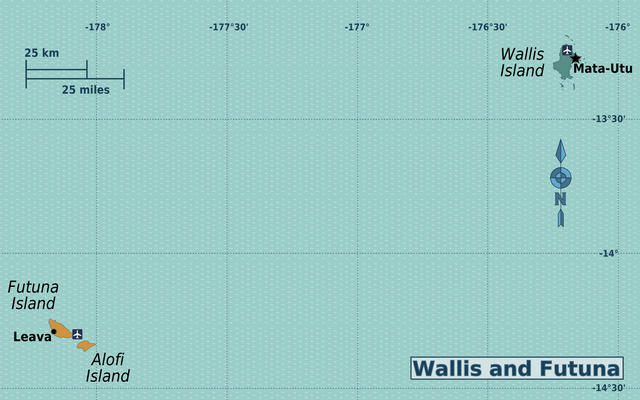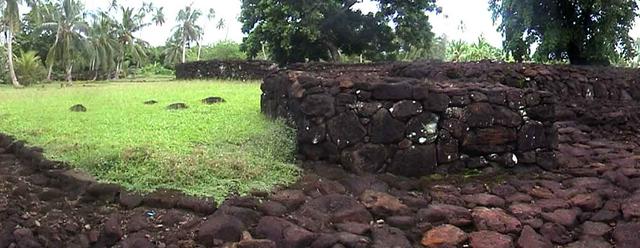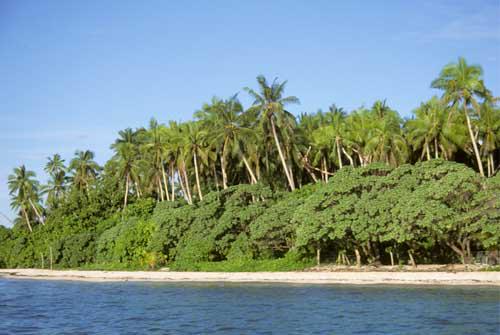Wallis and Futuna is an overseas community of France consisting of two small island groupings in Polynesia, near Fiji and Samoa.

Wallis and Futuna comprises two archipelagoes:
Hoorn Islands group (also known as the Futuna Islands, and as Îles Horne)
- Futuna Island (pop.~5,000)
- Alofi Island (uninhabited)
Alofi Island is the smaller of the two. According to legend it was as densely inhabited as Futuna up until the 19th century, when the Futuna people slaughtered and ate the population in a single raid.
Wallis Islands group (also known as ʻUvea, as is Wallis Island)
- Wallis Island (ʻUvea) (pop.~10,000)
Wallis Island is surrounded by 15 smaller islands, all of which are uninhabited.
- Mata-Utu. (Matāʻutu) - capital of Wallis and Futuna, also capital of Hahake District, on Wallis Island
- Leava. - the capital of the Sigavé chiefdom, and the third largest village on Futuna Island
Mata-Utu. (Matāʻutu) - capital of Wallis and Futuna, also capital of Hahake District, on [[Wallis Island]]
Leava. - the capital of the Sigavé chiefdom, and the third largest village on [[Futuna Island (Wallis and Futuna)|Futuna Island]]
Although visited by the Dutch and the British in the 17th and 18th centuries, it was the French who declared a protectorate over the islands in 1842. In 1959, the inhabitants of the islands voted to become a French overseas territory. There are still three ceremonial kingdoms within the territory: Alo, Sigave, Wallis.
The islands are volcanic in origin, with low hills, and fringing reefs. The highest point is Mont Singavi, at 765 m. The climate is tropical: hot, rainy season (November to April); cool, dry season (May to October); rains 2,500-3,000 mm per year (80% humidity); average temperature 26.6 °C.
 The collectivité recognises three official languages: French, Wallisian ('Uvean) and Futunian. About three quarters of the population in Wallis is bilingual. All official documents are written first in French and then in the language of the local island.
The collectivité recognises three official languages: French, Wallisian ('Uvean) and Futunian. About three quarters of the population in Wallis is bilingual. All official documents are written first in French and then in the language of the local island.
English is not very widely spoken among the Wallisian population, though most of the French population knows at least basic conversational English. But the bottom line is that it is highly recommended to arrive with a working knowledge of French.

- Talietumu fort on Wallis, built by the Tongans in the 15th century.
- Lake Laloalo on Wallis, a volcanic lake that is almost perfectly circular.
The CFP franc (called just franc locally) is the currency used in Wallis and Futuna, and also in the other Pacific territories of French Polynesia and New Caledonia. The initials CFP used to stand for Colonies Françaises du Pacifique (“French colonies of the Pacific”), but this was changed later to Communauté Financière du Pacifique (“Pacific Financial Community”) and finally to its current incarnation: Change Franc Pacifique (“Pacific Franc Exchange”). Throughout these successive changes the ISO 4217 currency code has remained XPF and pegged first to the French franc and then to the euro.

Banking facilities are limited, with no bank located on Futuna. Also, the BWF bank in Wallis will not directly change US $100 bills. Travelers are advised to do their currency exchanges in Nouméa, New Caledonia or Nadi, Fiji prior to arrival.
Tap water is not potable.
